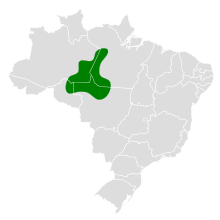Alta Floresta antpitta
| Alta Floresta antpitta | |
|---|---|

| |
| Scientific classification | |
| Domain: | Eukaryota |
| Kingdom: | Animalia |
| Phylum: | Chordata |
| Class: | Aves |
| Order: | Passeriformes |
| Family: | Grallariidae |
| Genus: | Hylopezus |
| Species: | H. whittakeri
|
| Binomial name | |
| Hylopezus whittakeri Carneiro et al., 2012
| |

| |
The Alta Floresta antpitta (Hylopezus whittakeri) is a species of bird in the family Grallariidae. It is endemic to Brazil.[1]
Taxonomy and systematics
[edit]The Alta Floresta antpitta was described for science in 2012 as part of a revision of the taxonomy of the spotted antpitta (Hylopezus macularius).[2] It had earlier been recognized as distinct but was thought to be part of Snethlage's antpitta (H. paraensis).[3] Following the 2012 publication, the International Ornithological Committee, the Clements taxonomy, and the South American Classification Committee of the American Ornithological Society recognized the new species.[1][4][5] However, as of early 2024 BirdLife International's Handbook of the Birds of the World (HBW) treats it as a subspecies of the spotted antpitta.[6]
The Alta Floresta antpitta is monotypic.[1]
Description
[edit]The Alta Floresta antpitta is about 14 cm (5.5 in) long and weighs about 40 to 47 g (1.4 to 1.7 oz). The sexes have the same plumage. Adults have buffy-orange lores and ring around the eye with a thin black crescent between them. Their ear coverts are speckled with blackish, grayish, and buff and have a black streak below them. Their forehead, crown, and nape are dark gray with blackish streaks at its lower edge. Their upperparts are olive-brown. Their wings are mostly olive-brown with a black rectangle and buffy bars showing on the coverts. They have a white "moustache" with a black stripe below it. Their throat is creamy white with a black line down from the bill. Their underparts are mostly creamy white with a buffy-cinnamon wash on their sides and flanks. Their breast has black flecks that diminish towards its lower end, their flanks, and belly. They have a dark brown iris, a gray-black maxilla, a pinkish mandible with a grayish outer third, and pale purple-pink legs and feet.[3]
Distribution and habitat
[edit]The Alta Floresta antpitta is found in the Amazon Basin of south-central Brazil, south of the Amazon between the Madeira and Xingu rivers. Its range includes parts of the states of Pará, Amazonas, Rondônia, and Mato Grosso. It inhabits humid lowland terra firme forest, where it favors swampy or flooded areas. It appears to be most numerous along watercourses and around gaps in the forest such as those caused by fallen trees. At the southern end of its range it also occurs in drier transitional forest.[3]
Behavior
[edit]Movement
[edit]The Alta Floresta antpitta is believed to be resident throughout its range.[3]
Feeding
[edit]The Alta Floresta antpitta's diet and foraging behavior are not known. They are assumed to be similar to those of other members of its genus, whose diet is invertebrates and small vertebrates.[3]
Breeding
[edit]Nothing is known about the Alta Floresta antpitta's breeding biology.[3]
Vocalization
[edit]The Alta Floresta antpitta's song is "composed of 5 (rarely 4 or 6) whistled notes with identical shapes, in which the second and third notes are separated by an unusually long interval".[3]
Status
[edit]The IUCN follows HBW taxonomy so it has not assessed Snethlage's antpitta separately from the spotted antpitta.[7] "Like other members of the Spotted Antpitta group, this species appears quite sensitive to habitat loss, fragmentation and perturbation [and] is also thought to be fairly sensitive to edges created by roads." It does occur in at least five protected areas.[3]
References
[edit]- ^ a b c Gill, Frank; Donsker, David; Rasmussen, Pamela, eds. (August 2024). "Antthrushes, antpittas, gnateaters, tapaculos, crescentchests". IOC World Bird List. v 14.2. Retrieved 19 August 2024.
- ^ Carneiro; Lincoln Silva; Gonzaga, Luiz Pedreira; Rêgo, Péricles S.; Sampaio, Iracilda; Schneider, Horacio; Aleixo, Alexandre (2012). "Systematic Revision of the Spotted Antpitta (Grallariidae: Hylopezus macularius), with Description of a Cryptic New Species from Brazilian Amazonia". The Auk. 129 (2): 338–351. doi:10.1525/auk.2012.11157. S2CID 84023178.
- ^ a b c d e f g h Greeney, H. F. and J. Fjeldså (2020). Alta Floresta Antpitta (Hylopezus whittakeri), version 1.0. In Birds of the World (S. M. Billerman, B. K. Keeney, P. G. Rodewald, and T. S. Schulenberg, Editors). Cornell Lab of Ornithology, Ithaca, NY, USA. https://doi.org/10.2173/bow.alfant1.01 Retrieved September 14, 2024
- ^ Clements, J. F., P.C. Rasmussen, T. S. Schulenberg, M. J. Iliff, T. A. Fredericks, J. A. Gerbracht, D. Lepage, A. Spencer, S. M. Billerman, B. L. Sullivan, and C. L. Wood. 2023. The eBird/Clements checklist of birds of the world: v2023. Downloaded from https://www.birds.cornell.edu/clementschecklist/download/ retrieved October 28, 2023
- ^ Remsen, J. V., Jr., J. I. Areta, E. Bonaccorso, S. Claramunt, G. Del-Rio, A. Jaramillo, D. F. Lane, M. B. Robbins, F. G. Stiles, and K. J. Zimmer. Version 27 July 2024. A classification of the bird species of South America. American Ornithological Society. https://www.museum.lsu.edu/~Remsen/SACCBaseline.htm retrieved July 28, 2024
- ^ HBW and BirdLife International (2024). Handbook of the Birds of the World and BirdLife International digital checklist of the birds of the world. Version 8.1. Available at: https://datazone.birdlife.org/species/taxonomy retrieved August 26, 2024
- ^ BirdLife International (2023). "Spotted Antpitta Hylopezus macularius". IUCN Red List of Threatened Species. 2023: e.T22724505A238948405. doi:10.2305/IUCN.UK.2023-1.RLTS.T22724505A238948405.en. Retrieved 14 September 2024.

